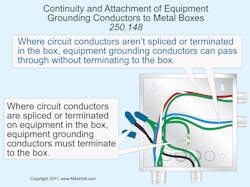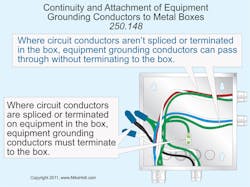Q. What is the requirement for attaching the equipment grounding conductor to metal boxes?
A. If circuit conductors are spliced or terminated on equipment within a metal box, the equipment grounding conductor associated with those circuits must be connected to the box in accordance with the following [250.148]: (see Figure)
Exception: The circuit equipment grounding conductor for an isolated ground receptacle installed in accordance with 250.146(D) isn't required to terminate to a metal box.
· Equipment grounding conductors must be spliced together with a device listed for the purpose [110.14(B) and 250.148(A)]. Note: Wire connectors of any color can be used with equipment grounding conductor splices, but green wire connectors can only be used with equipment grounding conductors.
· Equipment grounding conductors must terminate in a manner such that the disconnection or the removal of a receptacle, luminaire, or other device won't interrupt the grounding continuity [250.148(B)].
· Equipment grounding conductors within metal boxes must be connected to the metal box with a grounding screw that's not used for any other purpose, an equipment fitting listed for grounding, or a listed grounding device such as a ground clip [250.148(C)].
· Equipment grounding conductors aren't permitted to terminate to a screw that secures a plaster ring.
About the Author

Mike Holt
Mike Holt is the owner of Mike Holt Enterprises (www.MikeHolt.com), one of the largest electrical publishers in the United States. He earned a master's degree in the Business Administration Program (MBA) from the University of Miami. He earned his reputation as a National Electrical Code (NEC) expert by working his way up through the electrical trade. Formally a construction editor for two different trade publications, Mike started his career as an apprentice electrician and eventually became a master electrician, an electrical inspector, a contractor, and an educator. Mike has taught more than 1,000 classes on 30 different electrical-related subjects — ranging from alarm installations to exam preparation and voltage drop calculations. He continues to produce seminars, videos, books, and online training for the trade as well as contribute monthly Code content to EC&M magazine.

